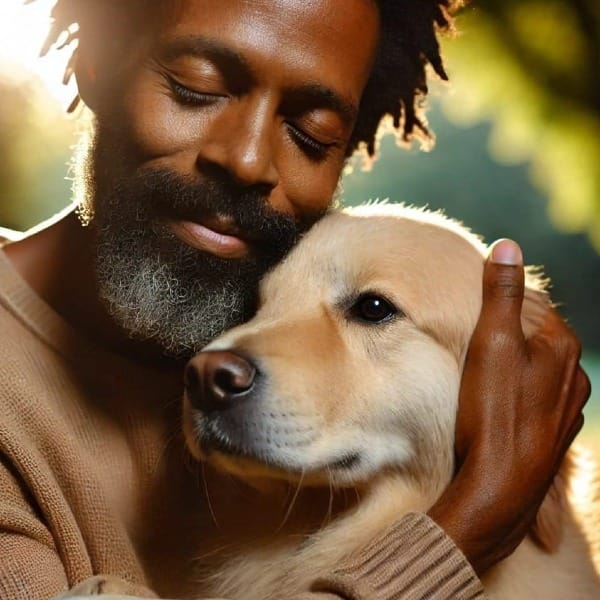What We Carry: African American Grief as a Measure of Love
A few days ago, someone reached out to tell me my dissertation gave them 'permission to simply grieve and be.' They were wrestling with feeling grief for their dog 'because...I'm Black.' Their message reminded me why we need to expand how we understand grief across cultures and communities.

A few days ago, I received an unexpected message that stopped me in my tracks:
"I came across your dynamic and affirming dissertation called 'Understanding Grief Experiences of Pet Loss Among African Americans.' I recently lost my dog and could not understand why I was grieving for longer than anticipated. Thank you for giving me the tools. I was sharing with a friend that I'm wrestling with feeling this much grief for a dog because…I'm Black. And that's when I started looking into whether there was a term for that, and then I came across your brilliant dissertation. From that, I learned about disenfranchised grief. Where there is societal pressure not to grieve things society doesn't deem as worthy. And I instantly felt better. Because that somehow gave me permission to simply grieve and be."
The timing of this message felt like more than coincidence. I'd been thinking about repurposing an essay I'd written—one that a national organization had ignored—and here was someone telling me exactly why this work matters. Sometimes the universe sends you exactly the confirmation you need.
The Weight We Carry
Grief has been a constant thread in my life—quiet, steady, and far heavier than most people realize.
I'm turning 49 years old on Monday, 😻 and when I look at the losses I've experienced—including both of my parents, all my grandparents, every aunt and uncle, and the tragic murder of my sister—it sometimes feels like I've attended more funerals than milestones. That kind of grief weighs heavily, especially at this age. And yet, I know I'm not alone. For many African Americans, particularly in families like mine, profound and layered loss becomes part of life's fabric. It's not always discussed, yet it's there—carried quietly and constantly.
As a certified grief educator, human services professional, and researcher, I've spent years reflecting on grief. I've also lived it. Through that dual perspective, I believe those of us who work with grieving individuals—whether in counseling, social work, healthcare, ministry, or education—have an opportunity to broaden how we understand and respond to grief, especially through a cultural lens. Grief is uncomfortable and unpredictable; in many ways, it resists easy categorization. It's something every person will experience, though in profoundly different ways. What's often missing in our conversations is the acknowledgment that while grief is universal, it is not uniform. It is shaped by cultural context—by history, language, family dynamics, spirituality, community expectations, and unspoken norms. For African Americans, those factors often carry additional weight.
When Research Meets Real Life
In my dissertation research on African American experiences of pet loss, I found that what participants shared extended far beyond the death of a companion animal. On the surface, their experiences may not seem different from those of any pet owner who has lost a beloved companion. Yet, within the cultural context of systemic inequities and generational perseverance in African American communities, their grief held a layered complexity. Yes, they spoke of love and connection, but they also expressed feelings of invalidation, lack of support, or being rushed through their mourning. Some were encouraged to "just get another one," as if their pain had an expiration date. Others revealed how the death of a pet unearthed long-standing grief from earlier life losses—losses that had never been fully acknowledged or given space to heal.
This research now lives in the world, reaching people like the person who messaged me—someone who was "wrestling with feeling this much grief for a dog because…I'm Black." Their words capture exactly what my participants described: the internalized pressure that certain griefs aren't worthy of our full attention, especially when filtered through cultural expectations about strength and resilience.

This mirrored my own experience. When my cat Samson passed away after 17 years by my side, the grief felt seismic, not because it was my first loss (far from it), but because, for the first time, I had the emotional space to feel it. Samson had been my quiet witness through the death of my mother, an emergency hysterectomy shortly thereafter, and the long, lonely stretch of figuring out how to live afterward. His loss cracked something open. What poured out wasn't just about him. When I think of Samson, I think of my mama. I think of the fact that she hated cats, yet somehow loved Samson. I think of how he was listed in her obituary as her "grandcat." I think of how an animal communicator told me that it was my mama who had received Samson when he crossed the Rainbow Bridge. Samson's loss reminded me of everything I had tucked away in the name of strength.
Beyond the Expected Narratives
As I reflected on my findings and my own journey, I realized that grief in African American communities is often expected to be filtered through survival. Cultural expectations of resilience, spiritual surrender, and emotional containment are deeply rooted. These strengths are invaluable, but they can also unintentionally silence the very emotions that human services seek to support. Research echoes this. Scholars have noted that grief literature and clinical models have historically centered on White, Western perspectives, often overlooking the cultural richness and variation in how people experience loss (Matthews et al., 2021; Moore et al., 2022). When grief in African American communities is acknowledged, it is frequently framed through trauma, violence, injustice, or historical oppression. While these are important and necessary to address, they are not the only forms of grief we face. There is also the quiet grief of caregiving, the slow ache of decline, the ambiguity of unresolved relationships, and the loss of deeply bonded companions—human or otherwise—that rarely receive formal recognition.
These expressions of grief are equally profound. They simply exist outside of what has been most studied, named, and visible in the dominant discourse. As professionals who encounter grief—whether as therapists, social workers, chaplains, nurses, teachers, or community leaders—our role is not to dictate how grief should appear. Our responsibility is to create space for it in all its forms. This includes grief shaped by culture, grief that doesn't meet clinical thresholds, and grief expressed through the subtle, complex emotions that elude diagnostic categories.
Expanding Our Understanding
Many are familiar with traditional "grief work" or the stages of grief introduced by Elizabeth Kübler-Ross. While foundational, these models can be expanded. Contemporary frameworks, such as the Dual Process Model of Coping with Bereavement (Stroebe & Schut, 1999), provide space for oscillation between loss-oriented and restoration-oriented coping. These models accommodate cultural nuance and allow for non-linear grieving processes.
This shift doesn't mean dismantling what we know; it means expanding it. We must expand our training to include cultural grief practices, our language to embrace nuance, and our assumptions to create space for those who grieve differently or who may not yet feel safe enough to grieve at all. Across disciplines, we already understand that healing is relational, that context matters, and that the personal is shaped by the societal. We simply need to remember that these truths apply to grief, too.
Permission to Grieve and Be
The person who reached out to me found something in my research that gave them "permission to simply grieve and be." That phrase stays with me because it captures something essential: sometimes we need permission to feel what we're feeling, especially when the world around us suggests our grief isn't quite legitimate enough.
Grief is not a weakness; it is a measure of love. When we begin to understand it through that lens—across cultures, communities, and contexts—our work with grieving individuals becomes more responsive, more inclusive, and ultimately more human. I share this not as someone who stands apart from the work, but as someone deeply embedded in it. I've experienced the intersection of personal loss and professional purpose. I believe there is room for both research and real life to inform how we care for others.
We all carry something. We all lose something. And we all deserve to be met with understanding when we do.
The message I received reminded me why this work matters beyond academic publications or professional presentations. It reaches people in their most vulnerable moments and says: your grief is valid, your love was real, and you have every right to feel exactly what you're feeling.
That's the power of creating space for all the ways we grieve. That's what it means to honor what we carry.
References
Matthews, J. J., Fonseca, F. D., & Varnado‐Johnson, C. D. (2021). Help‐seeking behaviors of African Americans after a loss. Journal of Multicultural Counseling and Development, 49(1), 60–71. https://doi.org/10.1002/jmcd.12206
Moore, S. E., Jones-Eversley, S. D., Tolliver, W. F., Wilson, B., & Harmon, D. K. (2022). Cultural responses to loss and grief among Black Americans: Theory and practice implications for clinicians. Death Studies, 46(1), 189–199. https://doi.org/10.1080/07481187.2020.1725930
Stroebe, M., & Schut, H. (1999). The dual process model of coping with bereavement: rationale and description. Death Studies, 23(3), 197–224. https://doi.org/10.1080/074811899201046



